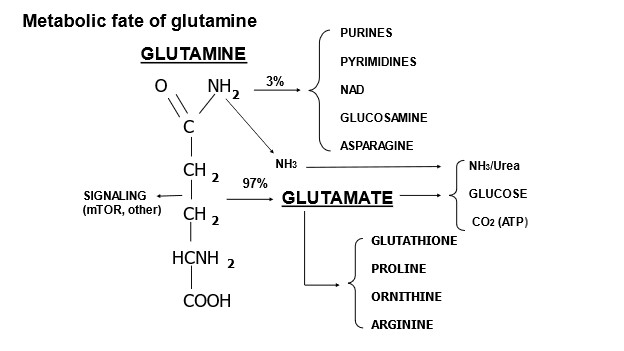
Specific Research Areas
My laboratory focuses on the role of amino acids (notably glutamine and glutamate) as substrates for gluconeogenesis and urea synthesis. This encompasses work in vitro and in vivo using cells and tissues from many different organs, as well as the use to date, of thirteen different species including, most recently, Orangutans. (I am a great believer in the August Krogh principle “for many problems in physiology there is an animal on which it can most conveniently studied”).

Tissue-specific glutamine metabolism
I have studied glutamine metabolism in liver, kidney, intestine, skeletal and cardiac muscle, adipose tissue, immune cells, and the lactating mammary gland. We were the first to isolate metabolically viable enterocytes and to identify the major end products of glucose, glutamine and glutamate metabolism in such cells. We developed the first aterio-difference techniques to quantify metabolic flux in rat adipose tissue in vivo and established that adipose tissue is a site of net glutamine synthesis. We recently established that adipocyte glutamine synthetase is involved in the adipocyte remodeling that occurs in obesity and that adipocytes can provide the glutamine that is essential to macrophage survival. We are continuing these studies with our recently developed Glul-/- mouse strain where the glutamine synthetase gene has been ablated in adipose tissue. The ultimate aim is to define the role of adipocyte glutamine synthesis in the development of obesity, insulin resistance and Type 2 diabetes. See below for work on lactation.
Regulation of phosphate activated glutaminase & glutamine synthetase
My group demonstrated that hepatic (liver-type) glutaminase (liver-type, GLS2) was subject to long-term hormonal and dietary regulation. We subsequently were the first to purify the liver-type glutaminase, raise antibodies to the protein, and to isolate and sequence both the cDNA and genomic clones. Glutaminase 2 is now the subject of extensive investigation in tumor biology. For many years we have also studied the opposing enzyme, glutamine synthetase (Glul), and have identified how this enzyme is regulated by glutamine induced proteolysis via the ubiquitin linked proteasome. We continue to study this enzyme in adipocyte differentiation (q.v.), and also in the provision of milk glutamine.
Glutamine and lactation
Glutamine and glutamate are the most abundant amino acids in milk and the free glutamine content rises considerably as lactation progresses. In horses and pigs we established that lactation is accompanied by a net catabolic state and a loss of lean body mass, caused, in part, by the need to provide glutamine in the milk. We showed that glutamine supplementation in the pig can prevent some of the lean body mass during lactation and also increase the glutamine content of the milk. Using the mouse we determined the localization of glutamine synthetase in the mammary gland and are currently working to determine how glutamine metabolism is regulated during lactation, in part by using our Glul-/- mouse line.
Metabolism in other species
One of my long-standing interests is the comparative biochemistry/physiology of nitrogen metabolism. To this end we have carried out extensive studies of uric acid production in species such as birds and lizards. Recently we have begun collaborations with anthropology faculty the dietary, and excretory, patterns of wild Orangutans.
Outstanding theoretical questions
I am continuously searching for ways to address the following questions (but the answers are not obvious and certainly not easy to test experimentally.
- Why do rapidly dividing and differentiating cells require the catabolism of extremely large amounts of glutamine?
- Are glutamine and glutamate dispensable or indispensable in the diet?
Teaching and education
I teach in our senior undergraduate and introductory graduate classes where I cover carbohydrate, proteins, energy expenditure and integrated metabolism. In addition, for many years I have taught intermediary metabolism and metabolic regulation at institutions in China, Brazil and Spain. This has resulted in a number of textbook and encyclopedia chapters, most recently:
- Watford, M. (2015) Starvation: Metabolic Changes. Encyclopedia of Life Sciences, John Wiley & Sons Ltd. Chichester, doi: 10.1002/9780470015902.a0000642.pub2
- Watford, M. (2020) Ornithine Cycle. Encyclopedia of Biochemistry, third edition, Elsevier, 00062 doi.1016/B978-0-12-819460 7.000621
- Watford, M. (2020) Glutamine. Encyclopedia of Biochemistry, third edition, Elsevier, 00028 doi.1016/B978-0-12-819460-7.00028-1
- Watford, M. (2022) Energy Metabolism. Encyclopedia of Human Nutrition, fourth edition, Elsevier, https://doi.org/10.1016/8978-0-12-821848-8.00073-1


